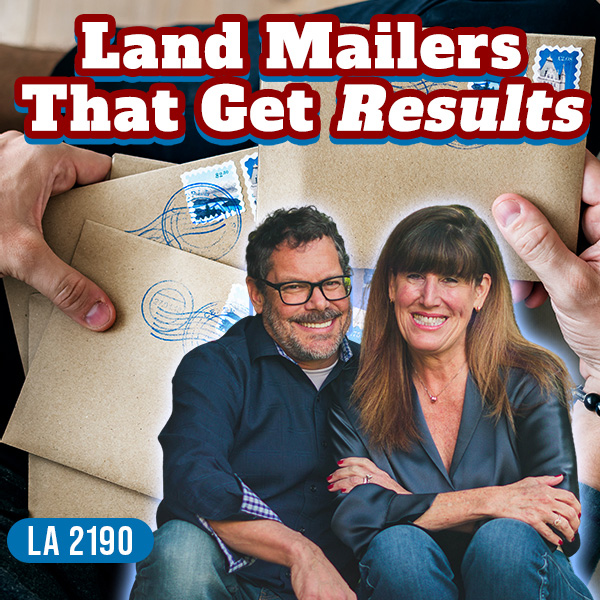This is episode number 2187. In this episode, Jill and I are talking about why most people price their land offers wrong.
I have some ideas.
Pricing Mistakes Are Rooted In Belief, Not Data
It’s not a technical thing. It’s a belief. Here’s a spoiler alert. People believe that the higher the price you offer, the more deals you’re going to do.
There’s a number that doesn’t make sense, too. “I’m going to send out an offer to everybody in this area for $1 million.” Dumb. You don’t want to do stuff like that. People will probably think, “I’ll get everybody to call me back, and then I’ll negotiate them down.” What a waste of time.
It’s a natural human response to think that price matters in a mailer. The fact is, it doesn’t. I’ll give you all the scenarios here in a couple of minutes.
Before we started the show, I almost blurted out that I would like a Bloody Mary, but you hit the start button.
We can do it next time.
We can do it when we’re done with this. What do you mean by next time?
I would love to have a Bloody Mary with you.
By the time we record next time, we’ll have them in our hands. I thought that was funny because I almost said that when you hit rolling. Jack is very sweet. He does make me nice drinks, and I appreciate that.
You’re a lot of fun.
Thanks.
Each day on the show, we answer a question from our Land Academy member Discord forum. Take a deep dive into land-related topics by popular request.
Tara wrote, “I’m putting this in the newbie section because we’re preparing our first mobile mailer. I’ve had some success with mobiles in the past, and I want to put more focus on them, but I’m a bit perplexed with pricing because mobile homes vary wildly as compared to other forms of real estate. Has anyone ever sent neutral letters and then negotiated a price based on the individual mobile? I’ve never sent neutral letters, but I’m wondering if it’s a viable option in this circumstance.”
No one I know is more qualified to answer this question than Jill. No one I know on the planet. I’ve been in this business for 35 years. I can’t wait to hear what you say.
Why Neutral Letters Fail
Zane and Tara, I know who you are, and I know you will get this. Do you want every single person that you sent a letter to with no dollar amount to call you and name their price? I don’t want that. We’ve tested it. We’ve tested everything that you can possibly imagine. I heard from a lot of people who did that, and then came over to our way and said, “That was a disaster.”
That’s the bottom line. You need to warm them up. You want to warm up and hit the right people where you’re coming from with a dollar that makes sense. That’s the whole point. If you don’t, that’s what’s going to happen. Everybody’s going to, “This is it. I know you think it’s worth $300,000, but this person wants our mobile so badly.”
Remember, you know how to personalize them. They don’t know if you sent out 5 letters or 5,000. They probably think you sent out five to their little street, like, “I’m going to be the first to call. They want to live on our street. Maybe it’s so-and-so’s kid. Who knows? We’re going to cash out $450,000. Fingers crossed.” That’s what’s going to happen.
We talked about Mrs. Jones having a cup of coffee and opening her mail. One of the things she opens is your letter, and the letter says, “Mrs. Jones, I’d like to buy a property for $13,000 in change in Mojave County, Arizona, or wherever.” The feeling that she has when she reads that sentence, the one that you want her to have, or the one that you want some percentage of the people who are opening your mail to have, is this. It is, “This is good timing. Three days ago, my husband and I were talking about selling a piece of land because we got the tax bill, and we’ve been paying the taxes on this thing. This is a good idea. I might want to sell this property.”
You planted that number in their head.
A neutral mailer that says, “That property that you guys have up there in Mojave County, I’d like to talk to you about selling it.” Mrs. Jones is not going to call you. Who’s going to call you is Mr. Smith. Mr. Smith says something like this right across the coffee table to his wife. “Baby, our ship came in. The property that we bought for $5,000 in 1958, we’re going to get $82,000 for that. Isn’t $82,000 what’s left on our mortgage?”
They think of a number that they heard someone sold their ag property for. That’s the problem. You plant the seed of who you are and what you want to do versus letting their minds run wild. Anybody who says, “I want to buy your house. Call me,” I’d be like, “The ship has come in. This is it. This is our time. Pack up.”
If Jill gets a letter that says, “I want to buy your house for $82,000,” you chuckle and throw it away. You are forcing the person with a neutral letter to think about price. Mrs. Jones is not thinking about price. She says, “I want to sell this. Are you kidding? We can get rid of this thing quickly.” She knows it’s worth more, or maybe she doesn’t. She doesn’t care. You’re addressing something else. A neutral letter attracts a different person. Immediately, they want to see what the price is, so they call you. It’s a useless phone call. We have done it both ways. I’ve made all the mistakes for 35 years. With neutral letters, you waste a ton of time and energy on the phone to maybe do a deal, but probably not.
Do you know what the thing is, Tara? I know you, and I know you know how much fun it is to take money away versus adding money. All you’re going to have is 3,000 phone calls with people where you’re going to talk them down. That’s not fun. For those reasons, I’m out.
The Real Purpose Of Including A Price
This taps right into the topic, why most people price their land offers wrong. You know a lot more about what most people’s property is worth than they do, so they’ll throw numbers out that they have no idea what they’re for.
I hear you. It’s two parts. Part A is that there’s a little bit more of a call to action, I want to say, and a feeling when there’s a dollar amount on the page that’s not $1, $500, $1,000, or a made-up number. That’s my thing. Someone put some time into this to give me this number. That’s a big deal versus a generic, “I want to buy your house,” kind of thing. That’s what I agree with. Jack’s part is that if they need the dough, they’re calling out. They’re going to call you. It’s not so much about the number.
We don’t have to agree on this, but for me personally, I need them warmed up. My job is answering the phone and getting a deal to happen where there wasn’t one. If they’re warmed up with a number, it makes my life so much easier. Someone with a neutral letter is a pain in the ass. It’s very hard. I don’t even like those calls. It’s hard to get deals done.
One of the great things about doing a mailer is that once you get used to it and know how to do it, it takes a few hours to get an entire mailer done. I’m not the gauge, but I can get a 10,000-unit mailer done and in the mail if Offers2Owners is compliant that day or they’re not too busy the same day. It goes out and I wait two weeks. Another week goes by, and then the entire three weeks.
I have leveraged that half a day’s work on my part and 4 or 5 people, and Jill’s doing 4 or 5 deals. That’s an amazing scale. It is a time leverage and a financial leverage, which I’ll talk about soon. It’s the cost of sending a mailer. When you send a neutral letter out, you’re doing away with that. You’re going to be on the phone for two weeks straight, listening to the people who want to sell their property, truly. The mailer worked. You leveraged it correctly.
Are we going to do the topic?
Yeah. The topic is, why do people price their land offers wrong? They do that.
That’s one of them. Neutral’s wrong. We covered that in great detail.
The whole point to a mailer is to send out a bunch of offers, maybe tens of thousands in our case, and have the six, ten, or twenty people that are interested in selling their property contact Jill, whether they mail the thing back, whether they call her and want a slight price adjustment, or however they contact us back.
When they do that, they’re having a life event 99% of the time. Not even 9 times out of 10, but 99% of the time it’s a life event. If you offered $20,000, $50,000, or $70,000 on a $100,000 piece of property, they don’t care. The $20,000 is fine. This is a human thing. There’s nothing wrong with you. I was like this in the beginning, too. The real reason people do this incorrectly is that they believe, “I’m going to offer more money because I want to do more deals. I’ve accepted the smaller profit margin.”
Please stop thinking that way entirely and completely. Offer 20%. Start at 20%. When you go through our program, I talk all about, at the end of a mailer, testing for reason. Please go through that. Your offer should be 20% or less. You should send out as many as you possibly can so that when they do call back, you’re getting a deal that’s 80% off of retail.
It could be more. That’s the whole point. I love that. Someone’s asking me about this climate that we’re in. The whole thing is that it’s not flying off the shelves. You’ve got to have great property at a great price. The flip side is that means there’s so much opportunity to pick up great properties at great, amazing prices. I had a group call, and I said, “Fast forward 1 year or even 2 years from now, we’re all going to be saying, ‘I wish I had 10 more of those.’”
You’re right, or 100 more.
We’re all going to be like, “I wish I had scooped them up.” When things aren’t moving as quickly, that’s the time to buy everything you can at your prices.
There are properties on the MLS that I have saved that are under contract. Some of them are sold that I wish I had bought. This is on the MLS. We never buy property in the MLS ever. There’s one very specific piece of dirt I regret not buying, and it’s gone. It was way undervalued. Somebody wanted to dump it.
That’s it.
Join us in the next episode where Jill and I discuss the real cost of sending a land offer campaign mailer. You are not alone in your real estate ambition. We’re Jack and Jill, information and inspiration to buy undervalued property.















